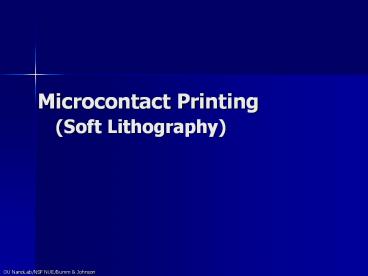Microcontact Printing (Soft Lithography) - PowerPoint PPT Presentation
Title:
Microcontact Printing (Soft Lithography)
Description:
Title: Microcontact Printing Author: Sage Last modified by: Lloyd A. Bumm Created Date: 7/2/2003 5:41:19 PM Document presentation format: On-screen Show – PowerPoint PPT presentation
Number of Views:797
Avg rating:3.0/5.0
Title: Microcontact Printing (Soft Lithography)
1
Microcontact Printing (Soft Lithography)
2
Outline
- Motivation
- History
- Schematic
- Procedure
- Photomask
- Snowflake
- "I Love NanoLab"
- OU interlock logo
- Stamp Master
- The stamp
- Chemistry of the Process
- Transferring the Pattern
- Etching the Substrate
- Examples
3
Motivation
- Production of silicon integrated circuits
- Patterning biological macromolecules, organic and
inorganic salts, colloidal materials, conducting
polymers, polymer beads - The figure to the right is a patterned rod
Image courtesy of Jackman et al, Science 1998.
vol. 280(5372) pp 2089-2091
4
Motivation Novel Example
- Transferring micrometer size pattern onto various
surfaces - Surface does not have to be flat (as opposed to
photolithography) - The figure to the right is an example of how one
would transfer patterns to a cylindrical rod
Image courtesy of Jackman et al, Science 1998.
vol. 280(5372) pp 2089-2091
5
History
- Both lithography and stamp printing have been
around for centuries - It was the combination of the two that gave rise
to microcontact printing - In 1993, Amit Kumar and George M. Whitesides
developed microcontact printing at Harvard
University - Subsequent methods of soft lithography have since
been explored - In 1996 IBM began research on improving optical
lithography in order to enhance the precision of
the printing process
6
Process Schematic
A prepolymer (2) covering the master (1) is cured
by heat or light and demolded to form an
elastomeric stamp (3), which is inked by
immersion (4) or with an ink pad (5) and printed
onto the substrate (6), forming a self-assembled
monolayer, which is transferred into the
substrate by a selective etch. Scanning electron
micrographs show the master, image of the stamp,
and the printed and etched pattern.
Image taken from http//www.aip.org/tip/INPHFA/vol
-8/iss-4/p16.pdf
7
Photomask
opaque
- Create desired pattern on computer (AutoCAD,
Adobe Illustrator, or your favorite graphics
program) - Print onto transparency
- Further reduction of size can done
photographically - Pattern must be in solid black and white and
printed using an opaque ink, which is determined
by the photoresist
8
About the Photomask Snowflake
- The snowflakes in the photomask are made such
that each subsequent one was half the size of the
previous one - Measurements were made regarding snowflake size
as well as distance between the snowflakes - These measurements were used to evaluate how well
the pattern transfer occurred - The depth of the stamp was determined (determined
by the master) - If the stamp is too shallow, there can be contact
in between the features - If the stamp is too deep, the features can be
distorted
0.629 mm
11.3 mm
9.175 mm
From Whitesides et. al paper
9
About the Photomask "I Love Nanolab"
- In this photomask, I Love Nanolab the largest
text (1) are 3mm by 21.3 mm. Each subsequent
set is half the size of the previous. - The smallest size (8) is 128 times smaller than
the biggest size, and is 23.4µm X 166.4µm
21.3 mm
3 mm
Dont YOU love NanoLab?
10
About the Photomask OU Logo
- In this photomask, the largest OU logo is 10 mm
wide and 13.7 mm long.
10 mm
13.7 mm
11
Stamp Master (mold)
- Done on glass slide using the mask as the source
of the pattern - Apply photoresist (10-20 µm)
- (MicroChem SU-8 2010) Spin coat for even
distribution - Cover Sample with Mask and Expose to UV light
- The resist will harden upon exposure (negative
resist) - Soft-Baking
- Put on hotplate, or oven for 3 minutes
- Develop
- Unexposed resist will be dissolved, while the
exposed resist remains - Wash Master and clean up
12
The Stamp
- Clean master sample and place in walled container
(disposable petri dish). - Pour silicone resin evenly over master
- The silicone resin is liquid polydimethylsiloxane
PDMS - Bake the PDMS to solidify (65C for 15-20h).
- Remove cured stamp from master and wash both in
EtOH
13
Chemistry of the Process
- Stamp is inked with a thiol (R-S-H)
- The thiol ink pattern is stamped onto the metal
surface - The thiol ink works as an etch resist
- Etching removes metal on uninked areas
- A thiol ink is 2mM solution of hexadecanethiol
- The substrate is a Pd or Au thin film evaporated
on polished Si wafer
14
Transferring the Pattern to a Thin Metal Film
- Wash both substrate (the metal) and the stamp in
EtOH - Using Q-Tip, coat the stamp with the thiol
solution and dry it - dry under N2 stream for 30sec
- Bring stamp into contact with substrate for 10
sec., remove stamp and dry substrate under N2
15
Useful Chemistry
- The sulfur atoms bonds to the metal (Pd or Au)
- The carbon chains of the thiol will then align
with each other to create a hydrophobic SAM
(self-assembling monolayer) - The monolayer acts as a protective coating
against the etchant - The best results are often obtained by the
longest chains because they create a larger and
therefore better barrier
16
Etching the Substrate
- Immerse substrate in diluted (13) etchant for
lt30 sec (Pd Etchant, type TFP in CYANIDE!!! be
careful, its highly toxic!) - The time here is very important!!! If you leave
it too long in the etch, you will most likely
remove ALL the Pd, if its not long enough, then
your pattern will not be fully developed. - Remove from etchant and immediately quench it in
deionized water, rinse and dry.
17
Good and Bad Examples
Black lines drawn to mark the edge of the
snowflakes































